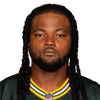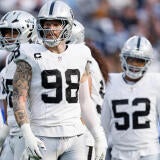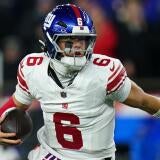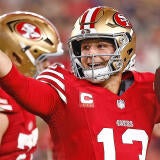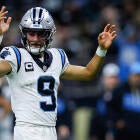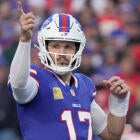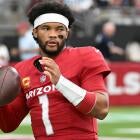NFC North 2020 preview: One homegrown player still on a rookie contract who is key for each team's success
As the season approaches, we take a look at the four young players who might just shape the landscape of the NFC North

Changes have come to the NFC North.
In Green Bay, the Packers have a new quarterback in Jordan Love who is expected to eventually replace Aaron Rodgers. In Chicago, the Bears have a new quarterback in Nick Foles who is expected to immediately compete with the incumbent starting quarterback, Mitchell Trubisky. In Minnesota, the Vikings parted ways with several key players from the past few seasons, most notably Stefon Diggs, but also three of their top four cornerbacks, which has created a void in the secondary that first-round pick Jeff Gladney will be given every opportunity to fill. Finally, in Detroit, the Lions traded away star cornerback Darius Slay and began again with rookie cornerback Jeff Okudah, as they hope 2020 is finally the year that Matt Patricia demonstrates his alleged ability to coach good defensive football.
After a chaotic offseason, the NFC North remains a highly competitive division. It sent two teams to the playoffs a year ago. It saw three of its teams finish at .500 or better. The fourth and worst team was actually 3-4-1 before losing its starting quarterback for the final half of the season and stumbling to a 3-12-1 record.
As such, the NFC North won't just be decided by the Aaron Rodgers, Kirk Cousins, Nick Foles, and Matthew Staffords of the division. It'll also be decided by up-and-coming players who have yet to make the leap from promising to good. With that in mind, we decided to take a look at one homegrown player from each of the four teams who is both still on their rookie contract and might just determine if their team survives the regular season and earns a playoff berth. We begin in Chicago, where the Bears are still searching for the competent offense their already great defense desperately needs in their quest to return to the postseason.
Chicago Bears: Anthony Miller
Drafted: No. 51 in 2018
Final year of rookie deal: 2021
Roquan Smith, a first-round pick in 2018, was a tempting choice, but Smith has already broken out over the past two seasons. The question with Smith isn't if he'll break out, it's if he'll make the leap from good to great. And if he doesn't, well, the Bears are still stacked on defense. They can get by just fine if Smith remains a good, but not great player.
The same can't be said for the Bears on offense. They are not stacked. The biggest question undoubtedly exists at quarterback, where Foles will be battling Trubisky for the starting job, but another big question needs to be asked at wide receiver opposite Allen Robinson.
Robinson was the only reliable offensive player for the Bears a season ago. He finished with 98 receptions, 1,147 yards, and seven touchdowns -- the next closest Bears wide receiver finished with 52 catches, 656 yards, and four touchdowns. It was Miller who caught those 52 passes for 656 yards, but it was Taylor Gabriel who caught those four touchdowns. Miller's task in 2020 -- in his third season since the Bears selected him in the second round of the 2018 draft -- is replacing Gabriel, who became a salary-cap casualty this offseason.
In both of his two seasons, Miller has flashed promise. His rookie season included only 33 catches and 423 yards, but also seven touchdowns. 2019 was supposed to be the season when Miller broke out in a big way. Instead, he stumbled in the first half. In games 1-9, he caught only 17 passes for 218 yards and zero touchdowns. But in the second half, Miller caught on. In games 10-16, he registered 35 receptions for 438 yards and two touchdowns. The final result was another promising season that lacked consistency.
2020 is the year the Bears need Miller to put it all together. Gabriel is gone. The offense is searching for answers after ranking 29th in both yards and points, and 25th in DVOA, which ended up costing them a spot in the playoffs. Robinson needs some help. Miller should be given the first chance to emerge as the team's second receiver. They need him to seize it, as they eye an improvement on offense to support their already great defense that is just begging for an average offense to help them push the Bears back into the postseason.
Detroit Lions: Jeff Okudah
Drafted: No. 3 in 2020
Final year of rookie deal: 2024 (fifth-year option available)
Expectations for Okudah in Year 1 aren't going to be tempered as a result of his draft position (third overall behind only Joe Burrow and Chase Young) and what happened before the Lions drafted him. In March, the Lions shipped star cornerback Darius Slay to Philadelphia, creating a gaping void in Detroit's secondary. Okudah will be expected to fill that void.
On a larger level, the Lions' defense desperately needs a revolution. Despite being coached by alleged defensive mastermind Matt Patricia and the team spending big money in free agency on the defense, the Lions trotted out the fifth-worst defense by DVOA a season ago. They ranked dead last in passing yards allowed. That's where Okudah comes into play.
At Ohio State in 2019, Okudah notched career-highs in both interceptions (three) and passes defended (nine). According to Pro Football Focus, over the final two years of his college career, in a span that included 27 games, he didn't allow more than 50 yards in a game, not once. He was far and away the best cornerback prospect in the draft, hence his selection at No. 3.
Obviously, one player shouldn't be expected to singlehandedly turn around a terrible defense. But if the Lions are going to go from worst to first or at the very least, become a competitive team in the NFC North, they'll need Okudah to live up to his potential. And they'll need him to do so immediately as a rookie.
Green Bay Packers: Rashan Gary
Drafted: No. 12 in 2019
Final year of rookie deal: 2023 (fifth-year option available)
It's clear the Packers are counting on their defense to continue their ascent in 2020. A year ago, the Packers went from the league's 29th-best defense to the league's 15th-best defense by DVOA, the result of the front office's commitment to strengthening the defense via the draft (with multiple first-round picks spent on defensive players) and free agency (with money being thrown at key positions like edge rusher and safety), and the arrival of defensive coordinator Mike Pettine. After a 2020 draft that focused more on the future -- life after Aaron Rodgers -- and can only be described as a Category-5 disaster that failed to address the team's glaring and immediate need at wide receiver, it seems as if the Packers are relying on another step forward by their defense.
And for that to happen, they'll need 2019 first-round pick Rashan Gary to demonstrate why they took him where they did. Gary did not do that in his rookie season, finishing the year with two sacks, three quarterback hits, three tackles for loss, and 21 combined tackles. Luckily for both the Packers and Gary, production from Za'Darius Smith and Preston Smith, who combined for 25.5 of the team's 41 sacks, made up for Gary's disappointing debut. It provided him with a degree of cover. But as the Packers try to prove their 13-3 season wasn't as fluky as many experts have deemed, they'll need Gary to make the leap and supply the Smiths with the support they might need in 2020.
I was tempted to select Jaire Alexander instead of Gary, but Alexander -- like Roquan Smith for the Bears -- has already proven he's a damn good player. I'm assuming he's going to continue his ascent. At worst, he'll remain a damn good player. Gary is the player who has more to prove. And the Packers have more to gain if he ascends in Year 2.
Minnesota Vikings: Jeff Gladney
Drafted: No. 31 in 2020
Final year of rookie deal: 2024 (fifth-year option available)
Before this year's draft came and went, the Vikings experienced a mass exodus of defense talent -- particularly at cornerback. Three key cornerbacks from 2019 moved on: Xavier Rhodes signed with the Colts while Mackensie Alexander and Trae Waynes both landed with the Bengals. In terms of overall snap counts, Rhodes and Waynes led the team's cornerbacks while Alexander ranked fourth behind Mike Hughes, who does at least remain on the roster.
But someone will need to play opposite Hughes, which is where Gladney comes into the equation. The penultimate pick of the first round of this year's draft, Gladney is going to be expected to produce immediately given the dearth of quality corners on the team's roster. Luckily for the Vikings, Gladney is coming off a college career at TCU where he registered five interceptions and 31 passes defended over his final three seasons. Luckily for Gladney, he gets to be coached up by Mike Zimmer, one of the league's top defensive minds.
As is also the case with Okudah for the Lions, it's probably not fair to expect Gladney to fill in seamlessly in Year 1. Transitioning from college to the pros, no matter how good of a prospect a player is, is never simple or easy. There's no doubt that Gladney is talented enough to do so. But it remains to be seen when it'll all come together.
Unlike Okudah, Gladney at least has the benefit of joining an already pretty good defense. The Vikings' defense ranked seventh in DVOA a year ago. Under Zimmer, they've finished with a top-10 defense by points allowed five times in six seasons -- and the one season they didn't, they still ranked 11th. There's reason to believe the Vikings will survive all of the losses they took in free agency. One of those reasons is Gladney, who won't be afforded much time to accumulate to the NFL. If the Vikings are going make their way back to the playoffs after an impressive 10-win season, they'll need Gladney to contribute immediately.
The other obvious pick here would've been fellow first-round pick Justin Jefferson, who is tasked with replacing Stefon Diggs. The Vikings will need both players to undergo a quick and successful transition to the NFL if they're going to journey back into January.




